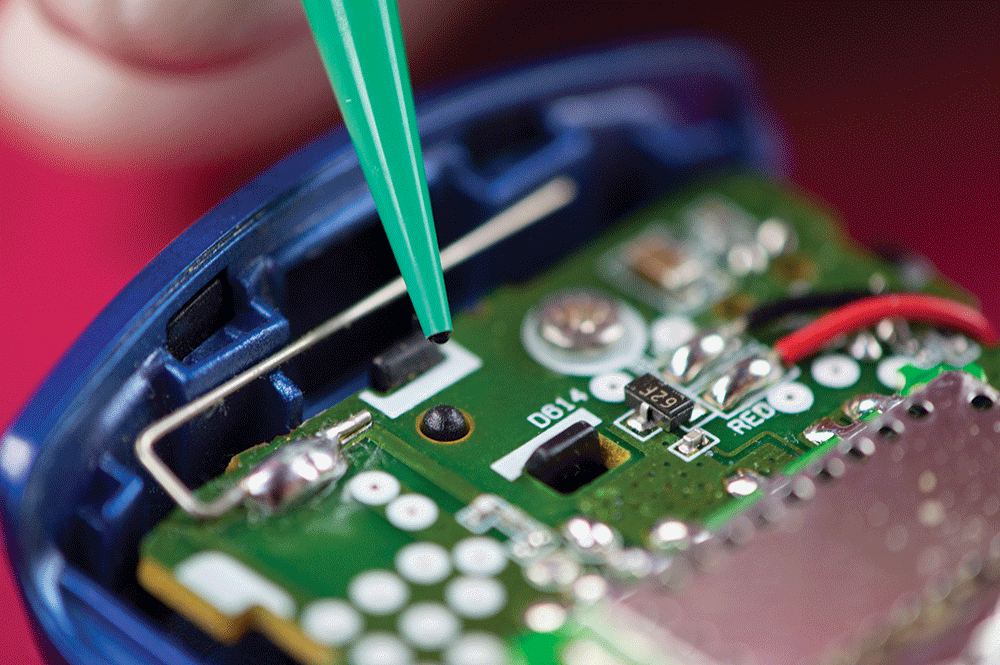In this interview, Rohit Ramnath, Senior Product Engineer at Master Bond Inc., discusses adhesive technologies addressing challenges in battery design, packaging, and thermal management, highlighting their critical role in enhancing the performance and durability of micro and EV battery systems.
What challenges do micro-scale batteries face, and how are epoxy adhesives used to address them?
Micro-scale batteries, often millimeter or centimeter in size, face challenges in designing and constructing a hermetic package due to their small scale. They are commonly used in miniaturized sensors, microelectronic devices, and micro-electro-mechanical systems (MEMS), where minimizing non-active weight in the packaging is critical. Lightweight epoxy adhesives with customizable rheology and flow profiles assist in reducing weight while supporting the complex construction process.

Image Credit: Master Bond, Inc.
Why does energy density decrease as battery size decreases, and why is hermetic packaging critical in smaller batteries?
Energy density decreases in smaller batteries because the weight percentage of packaging material increases due to the surface-area-to-volume (SA:V) relationship. As the battery's size shrinks, the surface area becomes relatively larger compared to the internal volume, shifting more weight to the packaging component. Hermetic packaging is critical because the liquid organic electrolytes in lithium-ion batteries, such as ethylene, dimethyl, or propylene carbonates, are volatile and can escape without a perfect seal, leading to decreased performance or battery failure.
Why is the chemical composition of epoxy adhesives critical in battery packaging?
Epoxy adhesives provide high temperature and chemical resistance while maintaining low permeability, which helps protect the sensitive chemical environment within a battery cell. To prevent contamination and avoid harmful chemical byproducts that could degrade battery performance, the epoxy’s outgassing behavior, cure schedule, and chemical resistance must be carefully tailored.
What are the key requirements for adhesives in battery cells, and how do epoxy adhesives address these challenges?
Adhesives in battery cells must resist corrosive salts, organic electrolytes, high temperatures, and pressures while maintaining chemical integrity. Breakdown of the adhesive can compromise the hermetic seal, leading to electrolyte volatilization and contamination from moisture. To mitigate these risks, adhesives must provide exceptional chemical resistance, low permeability to moisture and air, as well as the ability to provide excellent electrical insulation.
Epoxy adhesives are preferred for their high chemical as well as temperature resistance, low permeability, and stability. Unlike silicone adhesives, which have higher permeability, epoxy systems are better suited for hermetic applications. Permeability in adhesives depends on factors like chemical composition, cross-link density, polymer microstructure, and the glass transition temperature (Tg).

Image Credit: Master Bond, Inc.
How does the adhesive curing process impact battery performance?
Higher cure temperatures increase the risk of damaging sensitive battery components. To minimize these risks, moderate-temperature heat-cured epoxies or dual-cure systems using UV radiation and heat may be preferred.
How do thermally conductive adhesives support EV battery thermal management?
Thermally conductive adhesives are essential for managing heat in EV batteries. As battery temperatures rise, efficiency drops, and the risk of capacity loss, degradation, or failure increases. By helping to dissipate heat, these adhesives keep temperatures in the optimal range. Some specialty compounds also offer the added benefit of being flame retardant.
What role do silicone adhesives play in the encapsulation and sealing of EV battery packs?
Silicone adhesives are widely used in EV battery packs for their high-temperature resistance and sealing properties. They are used to secure individual cells within modules, providing reinforcement for electrical connections and absorbing shock as well as vibration to enhance the overall durability of the battery system.
About Rohit Ramnath 
Rohit Ramnath is a Senior Product Engineer with over 12 years of experience at Master Bond. He manages new product development from concept development to procurement to product launch via numerous marketing channels, such as news releases and case studies. Ramnath also troubleshoots customer adhesive application challenges in the medical, aerospace, electronics, optical, OEM, and oil and gas industries.
He co-authored Breakthrough Instruments and Products: Biocompatible Epoxies for Medical Device Manufacturing and holds a master’s degree in chemical engineering from Carnegie Mellon University.

This information has been sourced, reviewed and adapted from materials provided by Master Bond Inc.
For more information on this source, please visit Master Bond Inc.
Disclaimer: The views expressed here are those of the interviewee and do not necessarily represent the views of AZoM.com Limited (T/A) AZoNetwork, the owner and operator of this website. This disclaimer forms part of the Terms and Conditions of use of this website.